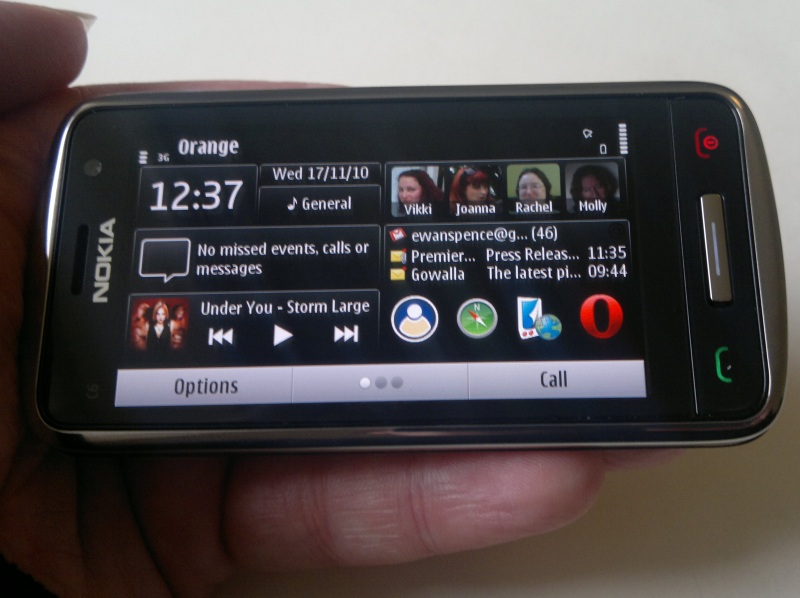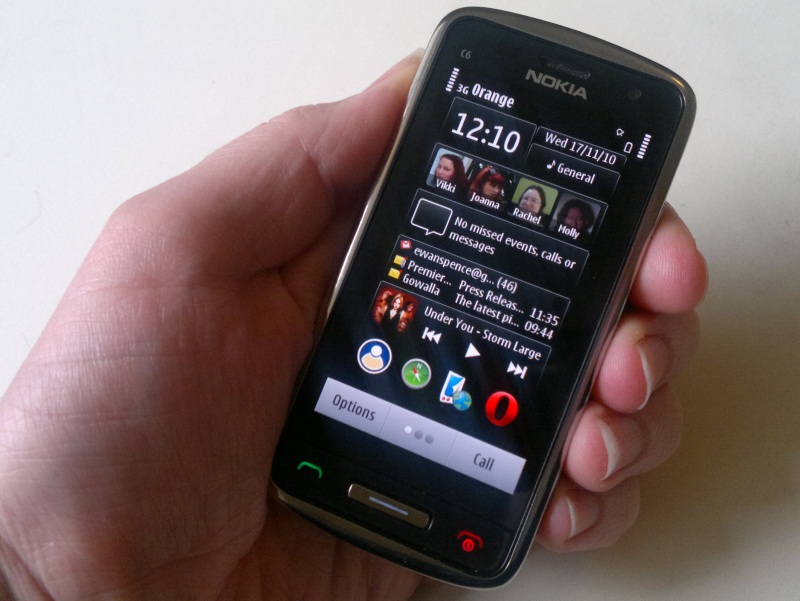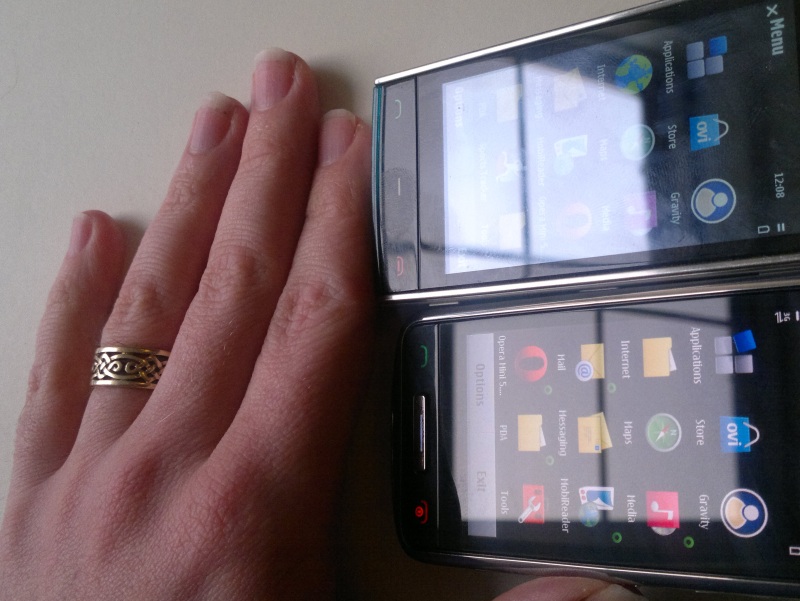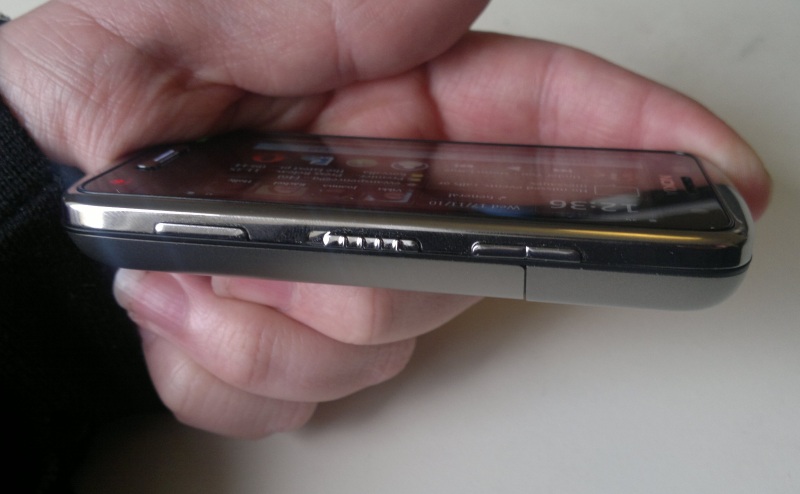Review: Nokia C6: part 1 - First Impressions
Of the four new Symbian devices, the Nokia C6-01 is likely to be the handset that sells in the greatest volume. This little smartphone packs almost as much power as its larger cousins, while delivering it in a much smarter (dare I say more feminine) style than the 'hard' look of the Nokia N8. And while the Symbian OS is largely identical to that in the other recently released handsets, the C6-01 has a different target audience for its software and hardware. So how does the hardware stand up in the first part of my Nokia C6-01 review.
(Can we take it as read that when I write C6 in this review, I mean the C6-01, running Symbian^3? Excellent. And before you ask, Steve and Rafe have an editorial in the making which will explain this seeming naming mis-step!).
So the Nokia C6 is here – while the tech heads and geeks are going to focus on the keyboard enabled E7, this was the device from Nokia World that I wanted to get my hands on. I thought then that this handset was going to fulfil the same role as the 5800 did for the first wave of Nokia's touch screen phones and take the latest version of Symbian OS to a huge number of people. It would do that partly on cost grounds (this is the smartphone that a lot of networks are going to push as the middle of the road monthly contract phone), partly on functionality (capacitive touch screen, GPS, eight megapixel camera) and partly on style.
Because this is a smart smartphone, and I've seen nothing in my time with the review unit that has dulled my first impression.
 The C6 in-hand and in landscape mode.
The C6 in-hand and in landscape mode.
Slightly squatter than the 5800, the eye is tricked into thinking this is not as “tall and thin” as the 5th Edition touchscreen phones. In fact, the screen is the same 3.2 inch 640x360 nHD resolution as devices like the X6. It wouldn't surprise me that the capacitive layer is exactly the same, the same gentle touch and pressure I'm used to on the X6 is all that is needed on the C6 to select menus, options, text, and interact with the device.
While there are external buttons, these are just the standard volume, keylock, camera, menu and call buttons – nothing superfluous is on show here, it's as simple as the Nokia designers can make it within their remit. To be honest I'm not even using the keylock slider – mostly because I'm finding it faster to press the central silver menu button and the on-screen unlock than it is to use the unlock slider, but also because the slider is quite stiff and my curled index finger doesn't have enough leverage to move it enough (and my thumb is right over the other buttons in the interface).
 ...and running in portrait mode.
...and running in portrait mode.
I'm bringing this stiff slider up because it's one of the very few grumbles I have about the construction of the C6. The ergonomics of this diminutive phone are well suited to the hand, the curve on the back of the phone allows it to sit comfortably in the hand for a long time. It's also a stainless steel cover around the back, lending a feel of solidity and weight to the device – without this, the C6 feels impossibly light, and while a very light smartphone might be something to aim for, the C6's construction balances that requirement with the need to make the C6 feel a solid and trustworthy phone.
One area that does look a bit cheap on the C6 is the loudspeaker grill – four oval shaped cutouts in the plastic below the camera lens might be economical to produce but would I be happy having it slide around a table at a pub, open to the elements as it is? No, I would not. Even the presence of small piece of mesh under the cut-out would be reassuring, but there's none of that here.
The screen, of course, is the big question. How good is this “blacker than black” display announced by Annsi Vanjoki with more than a passing nod to Spinal Tap? Well it's pretty impressive.
 Under strong Scottish sunlight, the C6-01 stays legible while the X6 washes out and has horrible reflections.
Under strong Scottish sunlight, the C6-01 stays legible while the X6 washes out and has horrible reflections.
The screen technology is an active matrix OLED screen, the same as that in the N8 and C7. The difference is the extra layer added by Nokia that goes by the name of CBD – the Clear Black dDisplay. This is a filter that has two goals – to reduce reflections on the screen, and to make the black a true black, thus boosting the contrast of the colours around them. Coupled with the physics of the screen requiring less power the more black there is on display, this makes the “coloured icons on black background” theme not only hugely power efficient but also one of the best Symbian screens out there.
Indoors, there's a noticeable difference between the C6 and the previous capacitive-screened X6 when under bright light, and the vibrancy of the colours is clear to see. Even next to a Nokia N8 (with a similar home screen layout of widgets) the C6 has the edge – not enough to sway a purchasing decision, but enough to be a factor.
Step outside though, and that's where you really see the change, and why the C6, even with its smaller size and slightly depressed specifications, is going to give those trying to decide which of the new smartphones to buy, a hard time. In weather that would see other phones almost impossible to view without angling my body to cast a shadow and squint hard, the C6 remains legible. Yes the colour still washes out, basic physics takes care of that, but the physics of having less reflections from the screen also comes into play to ensure you can still make out what is on display.
While Edinburgh at the start of winter allows only brief moments to test this, I'm confident that this could be taken out into bright, constant sunshine and be one of the most legible smartphones on the market today.
Is that enough to help swing a buying decision towards the C6? Because with identical software, there is very little technical difference between the N8, C7 and C6, it's all in the styling and maybe one headline feature. The N8 has its camera, the C7 has its fashionable good looks, and the C6 has the screen technology. Following it through, the E7 will have the keyboard, and I think that for a lot of those looking for a smartphone that does everything, the E7 is going to be the chosen one – and it also has the CBD display.
For me, the C6 is going to win out, but I know that's very much a personal decision based on the size of the phone. The C6, being smaller in height and thickness, is a far more pocketable device, either in the trouser or shirt pocket. Yes, the screen is smaller, but with the same number of pixels as the other new devices, the information on display is identical, and I prefer having a denser packing of the information. There's also the comfort factor, with the physical screen size identical to the X6. My fingers, eyes and fine motor memory are all keyed to this screen.
 Styling on the side of the C6.
Styling on the side of the C6.
Coming to the handset fresh, I think the overall size is going to be the most attractive feature to new customers. This is a small handset, and if it is marketed alongside the huge slabs of N8's and Android devices in the stores, but with the same connectivity and features emphasised, then it's going to be a huge hit.
But is it ever going to be considered a smartphone?
This is not a phone that's going to be pushed to those looking for power. It's further down the line, to those looking for connectivity while on the go, for a “social network” phone that happily talks to Facebook, Twitter and like, a phone that's going to be marketed to a lower common denominator than even the C7. That's a good thing in my opinion. Someone scared off by a hulking great big “complicated” phone like the N8 is more likely to be attracted to the C6 that just does what they want it to do.
This variant of the C6 (remember, it's officially the C6-01) in my mind is a winning design – from the curved steel back plate through to the very subtle lip around the top edge to the expansive glass of the touch screen. The buttons that are there are work well, with good feedback, and the tweaks to the vibration motor give a wonderful haptic feedback. In the thirty seconds that people will get to see this in store, the C6 becomes a winner, and that doesn't change over time.
Nokia's hardware team has delivered another winner. The question on the C6 is now what to make of the new flavour of Symbian software, and specifically how this is suited not for those looking for a smartphone, but for those who just want to get stuff done in the mid tier price range. And that'll be the next part of this review.
-- Ewan Spence, Nov 2010.
See also:
Nokia C6: part 2 - Is this the software you were hoping for?
Nokia C6: part 3 - Creating and Consuming Media
Nokia C6: part 4 - The real world and some final thoughts
Reviewed by Ewan Spence at
